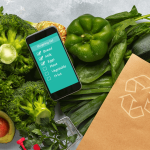Retail Food Waste and the Supply Chain
In the developed economy of the United States, approximately 80 percent of food loss takes place at the retail and consumer levels of the supply chain. Losses at the farm, transportation and processing levels account for the remaining 20 percent.
Some food losses at the retail level of the supply chain are unavoidable, such as damaged packaging, spillages, and spoilage due to technical malfunctions. Other culprits of loss, however, may be addressed by the corporation in an effort to reduce retail food waste.
Overstocking
As with retailers in other industries, grocers manage inventory based on expected consumer demand. When demand is not as great as anticipated, the retailer finds it has excess merchandise. However, unlike other products, fresh meat, seafood, produce and dairy products have an extremely limited shelf life. While retail outlets may be able to store non-perishable overstock, excess perishable items tend to become waste.
Consumer Preferences
Consumer perceptions and buying habits shape the way retailers operate. Retailers typically keep produce bins and meat counters fully stocked to avoid the negative consumer connotations associated with scarcity in the food supply. Perceptions of the quality of the food on display can differ depending on the volume of product represented. For example, a consumer may be more likely to purchase a piece of fruit from a display showcasing dozens of apples to chose from, rathe than a display with only a few apples. Of course, excess food that is not sold becomes waste.
Additionally, American consumers have become accustomed to purchasing perfectly shaped, blemish-free foods. With a plethora of choices in fully-stocked produce bins, consumers bypass fruits and vegetables of odd shapes and sizes, or those with natural blemishes. Though perfectly safe and healthy to eat, imperfect produce is much less likely to sell. These imperfect pieces of fruit or bunches of vegetables may be loaded straight from the pallet to the trash.
Sell by Dates
An estimated $900 million worth of inventory was pulled from U.S. shelves due to date code expiration in 2001. Much of this loss can be attributed to the misinterpretation of “sell by” and “best by” dates on food labels as expiration dates. With the public perception that food is not safe for consumption after the date printed by the manufacturer, retailers often pull products from the shelves as sell by dates are looming. This practice may protect retailers from negative press associated with selling “expired food.”
A Turnkey Solution
While changes in public perception of food fit for purchase and changes in retailer ordering and stocking procedures are needed to ensure long-term change in the creation of food waste, these approaches take time. By implementing food recycling programs in all grocery outlets, retailers can begin the process of creating real and lasting change in their operations. Quest’s comprehensive food recycling program can arm individual retail outlets and nation-wide corporations with the insight and reporting needed to manage and track food waste.
Start fighting food waste in your retail locations. Contact Quest today.
Retail Food Waste in the U.S. White Paper
For more information on retail food waste, download our latest white paper.
Image credit: billdayone/ Shutterstock









